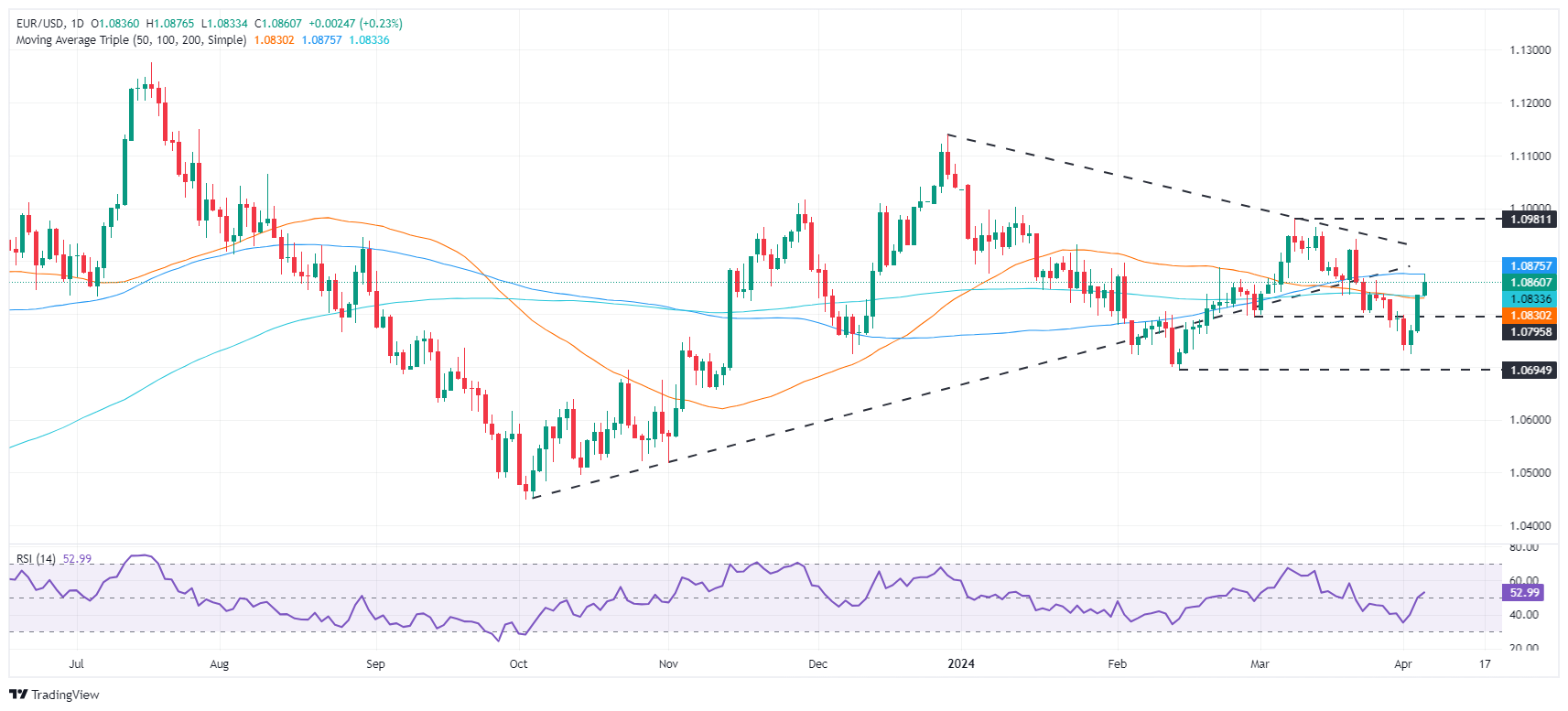- EUR/USD rises to 1.0858, facing 100-day MA resistance, influenced by US data and Eurozone PMIs.
- Rising jobless claims and trade deficit in the US, along with falling Treasury yields, weigh on the Dollar.
- The Fed's caution regarding rate cuts due to inflation and the improvement in Eurozone services PMIs support the Euro.
The Euro posts solid gains against the US Dollar, although it faces resistance from the 100-day moving average (DMA), which slows the pair's advance towards 1.0900. Weaker than expected US labor market data and more bullish Eurozone (EU) services PMIs favored the common currency. The EUR/USD pair is trading at 1.0858, up 0.21% on the day.
EUR/USD nears 1.0900, boosted by strong Eurozone PMIs and weak US labor market data
The dollar remains afloat after the US Bureau of Labor Statistics (BLS) revealed that initial claims for unemployment benefits for the week ending March 30 increased from 212,000 to 221,000, exceeding forecasts 214,000. At the same time, the US trade balance posted a deficit of $68.9 billion, above forecasts and the previous month's reading, providing a headwind for the US dollar.
US Treasury yields fell, as evidenced by the benchmark 10-year note rate falling to 4.31%, before resuming to 4.353%. The US Dollar Index (DXY), which measures the value of the currency against a basket of peers, fell 0.15% to 104.06 points.
Federal Reserve officials crossed the wires led by the Philadelphia Fed's Patrick Harker, claiming inflation is too high. Recently, Richmond Fed President Thomas Barkin said the Fed could be patient when it comes to cutting interest rates. He is optimistic about achieving a “soft landing,” although he complained about recent inflation data. Meanwhile, Chicago Fed President Austan Goolsbee stated that the biggest danger to inflation is pressures on housing prices. He added that if restrictive rates remain in place for too long, the labor market could begin to deteriorate.
Across the pond, Euro services PMIs improved across all blocs in March. The EU services PMI rose to 51.5, up from 50.2 in February. The German data grew for the first time in six months.
Given the context, operators continue to anticipate the ECB's first rate cut in June. On the contrary, market agents expect the first Fed cut for the July meeting, before the Jackson Hole symposium.
EUR/USD Price Analysis: Technical Outlook
The EUR/USD pair maintains a neutral trend as the price action fails to establish a lower low after recording consecutive lower highs. To the upside, the 100-DMA is key resistance at 1.0875, ahead of 1.0900. Buyers must overcome these two levels if they want to reach 1.1000. If sellers push prices below the confluence of the 50-DMA and 200-DMA at 1.0833, a decline towards 1.0800 is expected. The next turning point down is the April 2 low at 1.0724.

Frequently asked questions about the Euro
The Euro is the currency of the 20 countries of the European Union that belong to the Eurozone. It is the second most traded currency in the world, behind the US dollar. In 2022, it accounted for 31% of all foreign exchange transactions, with an average daily volume of more than $2.2 trillion per day. EUR/USD is the most traded currency pair in the world, accounting for an estimated 30% of all transactions, followed by EUR/JPY (4%), EUR/GBP (3%) and EUR/AUD (2% ).
The European Central Bank (ECB), headquartered in Frankfurt, Germany, is the reserve bank of the euro zone. The ECB sets interest rates and manages monetary policy. The ECB's main mandate is to maintain price stability, which means controlling inflation or stimulating growth. Its main instrument is to raise or lower interest rates. Relatively high interest rates – or the expectation of higher rates – tend to benefit the Euro and vice versa. The Governing Council of the ECB makes monetary policy decisions at meetings held eight times a year. Decisions are made by the heads of the eurozone's national banks and six permanent members, including ECB President Christine Lagarde.
Eurozone inflation data, measured by the Harmonized Index of Consumer Prices (HICP), are important econometric data for the Euro. If inflation rises more than expected, especially if it exceeds the ECB's 2% target, it forces the ECB to raise interest rates to bring it back under control. Relatively high interest rates compared to their peers tend to benefit the Euro, as it makes the region more attractive as a place for global investors to park their money.
The publication of economic data measures the health of the economy and can influence the value of the Euro. Indicators such as GDP, manufacturing and services PMIs, employment and consumer sentiment surveys can influence the direction of the single currency. A strong economy is good for the Euro. Not only does it attract more foreign investment, but it may encourage the ECB to raise interest rates, which will directly strengthen the Euro. Conversely, if economic data is weak, the Euro is likely to fall. The economic data for the four largest economies in the Eurozone (Germany, France, Italy and Spain) are especially significant, as they represent 75% of the Eurozone economy.
Another important publication for the Euro is the trade balance. This indicator measures the difference between what a country earns from its exports and what it spends on imports during a given period. If a country produces highly sought-after exports, its currency will appreciate due to the additional demand created by foreign buyers wishing to purchase these goods. Therefore, a positive net trade balance strengthens a currency and vice versa for a negative balance.
Source: Fx Street
I am Joshua Winder, a senior-level journalist and editor at World Stock Market. I specialize in covering news related to the stock market and economic trends. With more than 8 years of experience in this field, I have become an expert in financial reporting.







